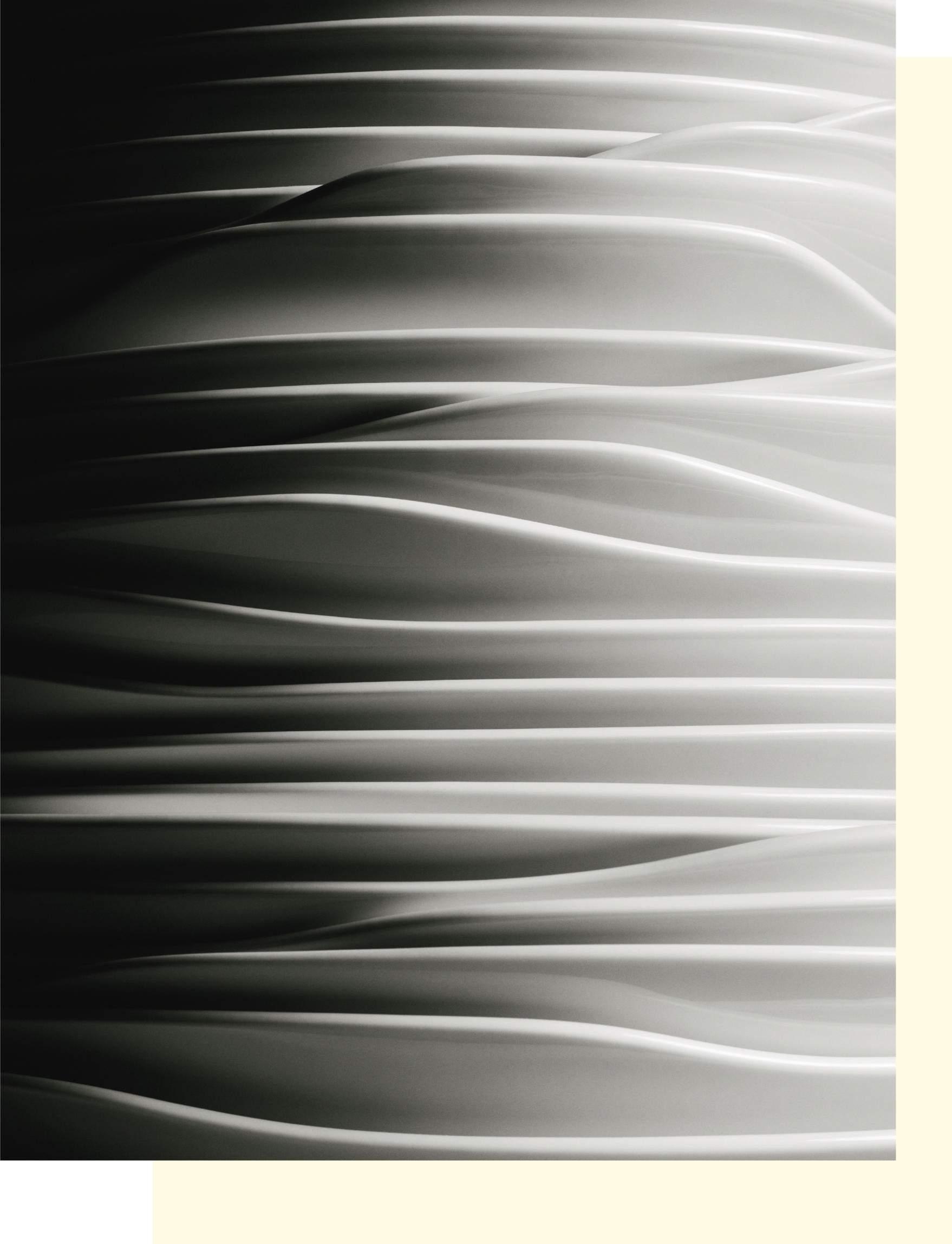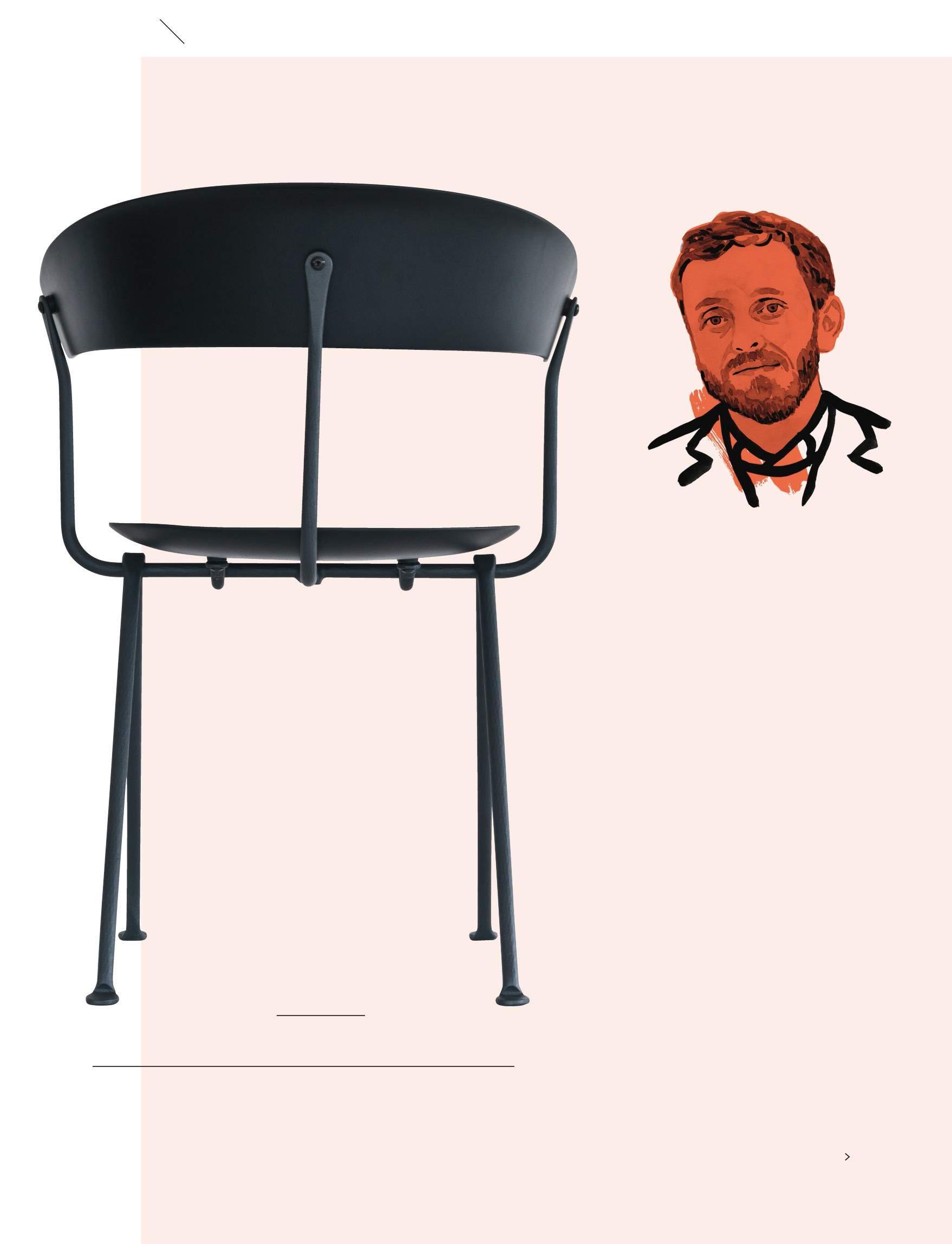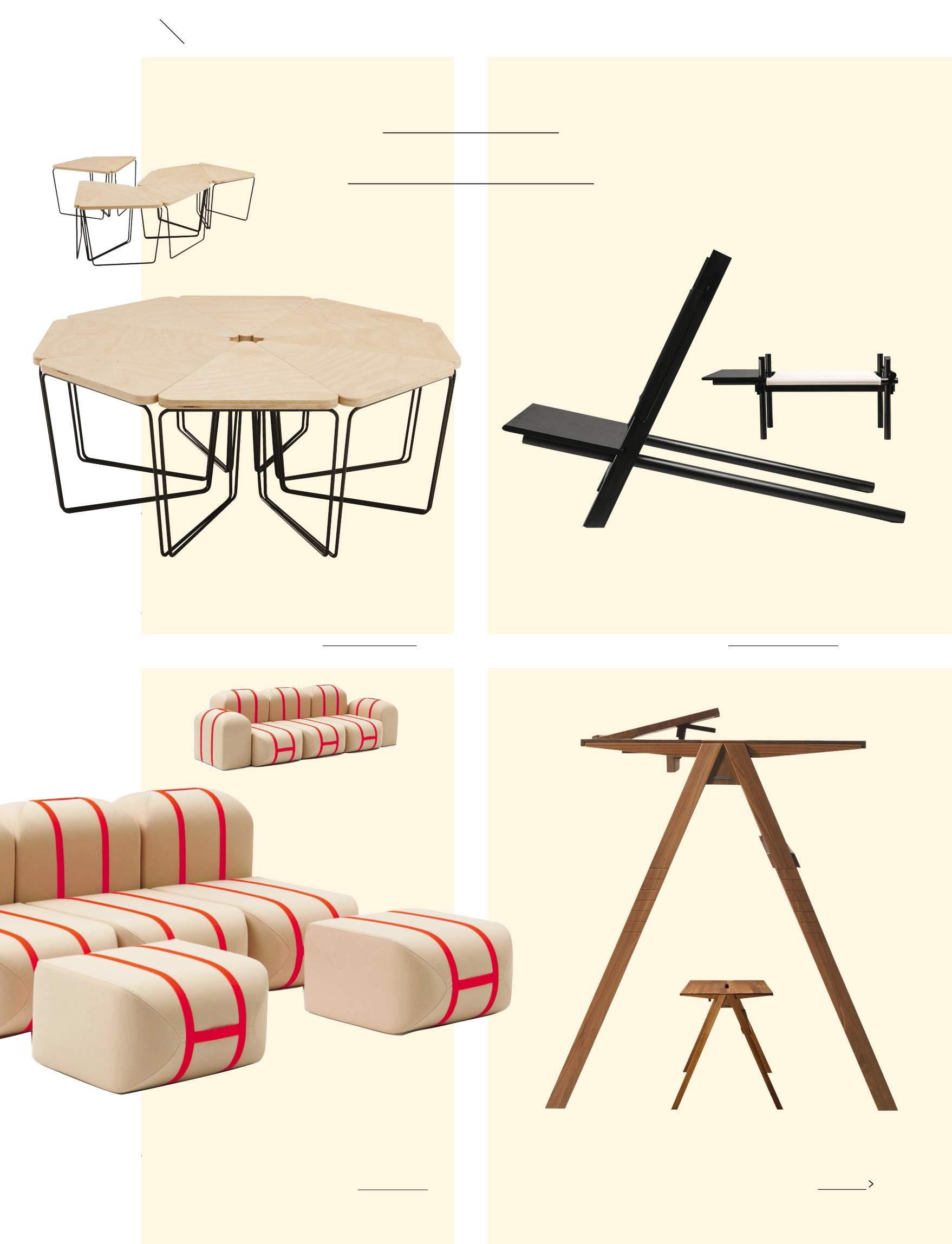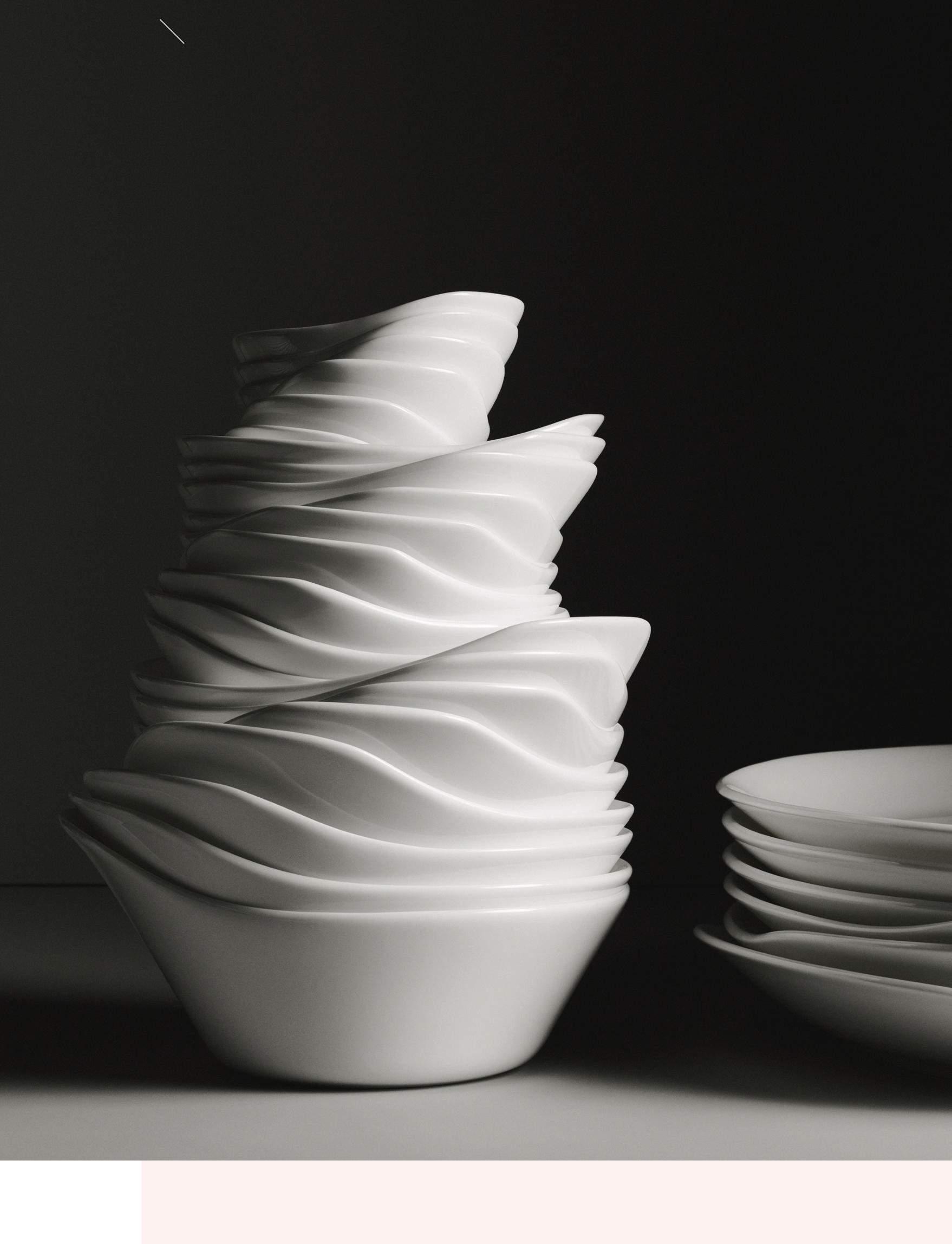
11 minute read
Modern World
A detail shot of Turkish designer Tamer Nakişçi’s latest collection of tableware. Read more on page 54.
36 Spotlight: BeatWoven Textiles 38 Conversation: Erwan Bouroullec 42 Product: 2015 Reissues 44 Product: Mirrors 48 Conversation: Michael Young 52 Product: Transformable Furniture
Advertisement
54 Spotlight: Tamer Nakişçi
Super Sonic
British designer Nadia-Anne Ricketts spins sound waves into graphic textile patterns.
What does your favorite song look like?
BeatWoven, the music-inspired textile line by London-based designer Nadia-Anne Ricketts, might just have the answer.
“It’s bizarre, but I always get a bit of a color palette in my head when I hear music,” says Ricketts, who transforms songs into silk using a proprietary software that helps her visualize sound. From there, the designer intuitively adds color and edits the patterns before they’re woven on digital jacquard looms at a British silk mill that dates back to the 18th century.
“I usually think of an interior story and then choose music that fits within that story,” says Ricketts of her audiovisual inspirations. British pop music served as the starting point for the collection she debuted stateside at this year’s International Contemporary Furniture Fair, and she is currently working on a new line inspired by jazz, as well as private commissions. Think of it as music for your eyes.

BeatWoven’s DreaMelody: Patterns in Play collection features designs derived by custom software from musical patterns in iconic British pop songs, including Queen’s “A Kind of Magic” and “Lucy in the Sky with Diamonds” by The Beatles. The large cushion with piping is $450; small pillows are $300.
Erwan and Ronan Bouroullec’s new Officina collection for Magis includes chairs, stools, and tables made with wroughtiron frames, marking the brothers’ first experimentation with the material. In this ageold technique, iron is hammered into shape by hand.
Q&A: Erwan Bouroullec

The French product designer provides food for thought on the new wrought-iron collection he and his brother, Ronan, designed for Magis.
illustration by Sam Kerr
Since 1999, brothers Erwan and Rowan Bouroullec have run an independent practice from their Paris-based studio, working with furniture brands such as Vitra, Kvadrat, and Cappellini. This year, they launched the Officina collection with Magis, using wrought iron to achieve the modern, elegantly functional pieces for which they are known. We caught up with Erwan at the Milan Furniture Fair to get his thoughts on the use of an ancient technique for a contemporary collection, and how production choices hold the power to shape the industry.
How did you first approach the idea of using a traditional method for a contemporary line?
If you compare it to cooking, to play with wrought iron is just like having an incredible fish—a beautiful one, like whole tuna. You shouldn’t do anything. You should just slice it perfectly and maybe bring just a little something. Because in the end, design techniques are like a flavor or seasoning. In the case of wrought iron, you’ve got a really, really rare flavor.
How do you feel it contrasts with more common methods or materials, like aluminum or powder-coated metals?
It’s so strong because it’s filled with history, first. Then also, it’s filled with some
The Officina collection offers a range of material options, including steel, tempered glass, American walnut, Carrara marble, Ardesia slate, and leather. Shown here are the chair and table with galvanized, gray metallized frames; on the previous spread, a black wrought-iron frame is paired with a polypropylene seat and back. incredibly primal steps: You see it, hammer it, heat it—fire, melt, poof! Hammer it into shape, and that’s it. As soon as we were confronted with it, it posed a big dilemma. It really took us a while to achieve such simplicity.

How do you feel this fits into your trajectory of work as a designer?
One responsibility that I understand, more and more, is that in the end, we work with companies, and those companies are partially in danger. Most of them are European, producing locally in Europe, so we have to think carefully when we do things. Now, with globalization and the movement of everything, design has to be much better every time. You need to find some clue— a reason—to resist local production.
Have you found there are others that share your desire for a more organic way of producing things?
I’m happy I’m working with some producers that all have high expectations for good design. So, they’ve got different production techniques. Some of them are more industrial, some of them are less, but at least something that they all share is that if you do something, it has to be worth doing it.
To you, what makes it worth it?
One of the biggest considerations behind furniture is to make pieces that are able to travel time. If you look at all the production of the ’90s and the design, a lot of things were not able to do that. They were getting old instantly, and they were getting old by their visual language, and also by their function. They were just not necessary. This is one of the worst things you can do for furniture. They have to be able to be kind of non-temporal. In this regard, I think we work with the right partners.
—Erwan Bouroullec, designer
New Editions
Back in production this year, these classic reissues prove good taste has no expiration date.
Joy shelf for Zanotta, $3,511 Achille Castiglioni’s rotating shelf unit, which first debuted in 1989, was unveiled in two new colorways at this year’s Milan Furniture Fair: burgundy and dark blue-green. zanotta.it Patricia Urquiola

Tufty-Time ‘15 for B&B Italia, $11,418 for a three-element sectional For its 10th anniversary, Patricia Urquiola’s modular seating system is reimagined with a new pleated cover, arriving to U.S. stores in November. bebitalia.com
Eileen Gray Franco Albini
Mirror, Mirror
Whether wall-mounted, freestanding, or handheld, these adventurous sculptural shapes and accents have us reflecting upon the traditional looking glass.
Present Perimeter by Jonathan Nesci for Patrick Parrish Gallery, from $800 Part of a larger collection of tables and accessories, Nesci’s limited edition of powder-coated, steelframe mirrors combine the geometric forms of hexagons, trapezoids, rhombuses, and triangles. patrickparrish.com
text by Aileen Kwun

Jonathan Nesci
Not since the days of disco have mirrors
been this hot. As signs of other movements from the 1960s and ’70s continue to reemerge through a contemporary filter— think tufted cushions, pastels, and illustrative, all-over patterns—mirrors, too, have become ripe for reinvention as an underexamined staple of interior design.
This was especially evident this spring, as the annual orbit of trade fairs saw designers introduce pieces that looked beyond the form as more than a mere reflector. Abstracted shapes, fine materials, finishes, and color-blocked accents all made an appearance, as did Op Art patterns and sculptural structures reminding us that mirrors can take on a dimensional, physical, and even space-defining presence. Functional aspects, too, were reimagined, with tactile grips and sturdy bases that suggested compact solutions and novel placements.
Representing the fairest of them all, the following selections challenge our gaze upon the conventional mirror—or at least make us acutely more aware of it, in a visual manner especially #trending among a generation of Instagram-friendly onlookers. In the age of the selfie, it seems, the beauty of a reflection lies not only in the eye of the beholder, but the apparatus through which it’s framed.

Danny Giannella and Tammer Hijazi
Joseph Guerra and Sina Sohrab
Utility Mirror Pocket by Visibility for Good Thing, $24 Available in three shapes, these handheld, stainless-steel mirrors are polished to a reflective finish then given a colorful, industrial rubber tool grip. goodthingny.com

Zoë Mowat Line Mirror by Bower, from $6,500 The curvilinear stripes of this mirror lend eye-popping dimension and a groovy Op Art vibe to an otherwise flat surface—without creating any unbecoming distortion effects. bowernyc.com
Hillary Taymour and Gillian Wilkins
Young’s <5_MY chair for Coalesse, $1,700, is a cuttingedge carbon-fiber design that weighs in at less than five pounds. The chair was inspired by his work with bicycles, is stackable for easy storage, and can be customized to match any color using an app.
illustration by Sam Kerr
With studios in Hong Kong and Brussels, British-born designer Michael Young uses the latest technological tools to push furniture forward. This year alone, he created a chair for Coalesse, launched his own furniture and lighting line, EOQ, and debuted a glassware prototype in memory of his dear friend (and fellow British expat) James Irvine. Here, he shares his take on material matters and reveals what he finds so exciting about the business of design today.
How does experimenting with materials play into your practice?
It’s pretty much the reason my studio is in Hong Kong, because you have some great factories. Anyone can design a classic chair and bang it out and there you go. I think to be involved in technology as it progresses through time is more relevant. It’s a pretty important part of the studio’s ethos to work with new precious materials and just progress, not stagnate.

We see so many different contemporary designers collaborating with multiple companies—what’s that doing for contemporary design?
Things seem to be getting more and more sophisticated, to be honest with you. You look at what’s going on with Magis and Moroso and Moooi and Emeco. Design is getting better. The manufacturing ability and sophistication of objects is growing very beautifully. The demand is increasing. I think it’s a really good moment where designers are now doing better and better
Q&A: Michael Young
The prolific Hong Kong designer muses on how major brand collaborations are accelerating innovation.
Young lauched his EOQ line at New York’s International Contemporary Furniture Fair, showcasing material-driven pieces like the Shindo chair (left), $2,775, a lightweight creation made from 20 layers of carbon-fiber twill weaves. Chelsea Boy, a protoype gin-and-tonic glass (below) dedicated to his late friend, designer James Irvine, was presented at Bar Basso during the Milan Furniture Fair.
work, and technology’s getting more sophisticated. This is really a very good decade for design.
Do you think this collaboration runs the risk of everything looking too similar?
There’s definitely a danger of that. How do you differentiate with chair design any longer? There are so many chairs on the market. I don’t think it’s about making a difference. It’s about evolution, really. I think a lot of the things that Kartell and Vitra and Magis are doing are showing that level of poetry, using new technologies to repeat history.

Are manufacturing processes where furniture design can evolve the most?
Yes. In many ways, most things have been done before, and it’s technology where you can make that small change. At the end of the day, furniture really shouldn’t look like it belongs in a spaceship. I love warm, authentic aesthetics. I guess the Coalesse chair is a fairly modern take on a chair, but it’s got its market segment, and that’s it. We know the market exists for that particular chair, so that’s why it was designed.
“History informs you more than the future. I don’t know what the future is.” —Michael Young, designer

At Your Discretion
Flexible and interchangeable, these shape-shifting designs can be used in varying configurations.
Nicholas Karlovasitis and Sarah Gibson
Fractal for DesignByThem, $188 per unit The eight petals of this modular table can be magnetically linked to form a large octagonal surface, or separated and aligned into different arrangements. designbythem.com Nin Truong and Christa Thomas

Contrast for Blk Pine, $1,100–$1,400 The Seattle workshop’s debut furniture collection uses a pared down, kit-of-parts construction that allows a lounge chair to easily morph into a side bench. blkpineworkshop.com
Matali Crasset Björn Kersting

text by Aileen Kwun photo by Jamie Chung

Tamer Nakişçi was one of 11 designers
to be spotlighted in this year’s ICFF Studio, a scholarship program and competition for emerging talents to take their single best prototype on the industry-wide stage during ICFF. For his presentation, the 32-year-old Turkish designer exhibited the Relax tabletop collection, a 14-piece bone china set with subtle, irregularly undulating edges that form a biomorphic effect when stacked in multiples.
“As a designer, I have always been interested in the relationship between objects, spaces, and people,” he says, noting that the varying shapes of the plates are meant to introduce an element of tactile surprise to the everyday.
Since the launch of ICFF Studio 10 years ago by the fair’s organizers and Jerry Helling, president of Bernhardt Design, the program has forecasted the rise of several established designers, including Jonah Takagi, Ini Archibong, Brad Ascalon, Nolen Niu, and Rita Jiang—many of whom have gone on to successfully establish their own practices. Nakişçi, who splits his time between London and Istanbul, collaborating with his brother at his family’s interiors firm, holds similar ambitions. This fall, he plans to bring his winning design into production through his own independent brand and latest venture, Futureisblank.
“I believe that design has the power to restore our consciousness and change our perspective about the things around us,” he says, on the experimental nature of the project. “I’m trying to wake people up, and take them back to that stage where they believe everything is possible, and the future is blank.”









